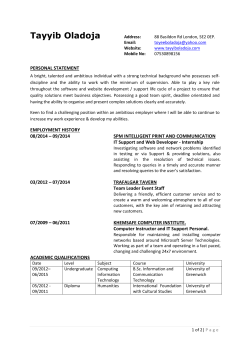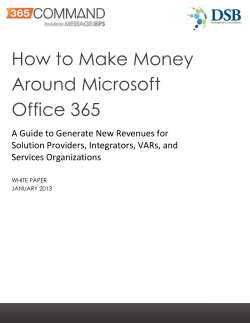
Document 390300
Defining usage models Defining personas Identifying sites, links, users Types of Lync traffic in modeling Look and feel 2 YOU ARE HERE Preengagement SOW Kick-Off Meeting Tools Logistics Discovery Session Usage Modelling Traffic Simulation Recommendations Back office Workers Typically work from the office IM and voice Primarily internal communication Sales representatives Often work from outside the office IM, Voice, Conferencing Many interactions with customers (lots of PSTN calls) Used as the baseline for the traffic simulation For example, > 20% talk time in typical enterprise environment is unrealistic. Trending towards an IM and video world and not and email and voice world Define usage ART models ART Identify and define personas Identify sites, links, and SCIENCE users SCIENCE Calculate and interpret ART results ART Usage models define how much users are communicating using a specific modality Personas define groups of users with common communication characteristics and work habits Sites, links, and users are customer data taken straight from the Data Discovery phase of the network assessment Another round of calculations and analysis might be needed Helps you to become a trusted advisor Default values (start with these) Typical as seen in modern enterprise deployments Adjustments based on organization’s policies (restrict or encourage certain communications methods) Utilization of Lync modalities as defined in usage models: none, low, medium, high Can be job-related (for example, ”our sales reps make plenty of PSTN voice calls”). Can be related to administrative policy (for example, “video calls are not allowed for vendors in our organization”). Percentage of users working remotely: 0% – 100% Others factors related to administrative policies or users behavior How do people work in the organization as of today? What groups of people can be identified? What are work habits in these groups? Are meetings a common way of working? Is it common for employees to work remotely? Medium works in most typical scenarios Change to Low or High if you have specific guideline from the customer Changing to None has much bigger impact None is always 0% Modality IM/P Impact Is it really a RTC ? * No Audio Yes Video Yes App/Desktop Sharing No Central sites Branch sites Total size of WAN link Amount of WAN link that might be used by Lync RTC So what is the RTC? Does the customer have QoS classes? Industry standard – 30% Internet links (if applicable) Total user population is not enough How many employees and how do they work? Refer to ”Usage models” and ”Personas” Visitors add to the traffic requirements Intra-pool and SQL BE Over the LAN Inter-pool SIP Signaling Data replication for backup pool Signaling Media Content SIP signaling (includes presence) Instant Messaging Peer-to-peer audio and video Multiparty audio Multiparty video PSTN audio Desktop/application sharing YELLOW= primary focus in the NA RED = secondary focus in the NA BLACK = only partially in the NA (only in modeling) File transfer PowerPoint sharing Conference attachments Persistent Chat communication Green Yellow Red …and Grey = formulas or results (locked cells) Validations Checks Within limits Within limits, but above threshold Outside limits Comments Using the Bandwidth Calculator © 2013 Microsoft Corporation. All rights reserved. Microsoft, Windows, and other product names are or may be registered trademarks and/or trademarks in the U.S. and/or other countries. The information herein is for informational purposes only and represents the current view of Microsoft Corporation as of the date of this presentation. Because Microsoft must respond to changing market conditions, it should not be interpreted to be a commitment on the part of Microsoft, and Microsoft cannot guarantee the accuracy of any information provided after the date of this presentation. MICROSOFT MAKES NO WARRANTIES, EXPRESS, IMPLIED OR STATUTORY, AS TO THE INFORMATION IN THIS PRESENTATION.
© Copyright 2025





















